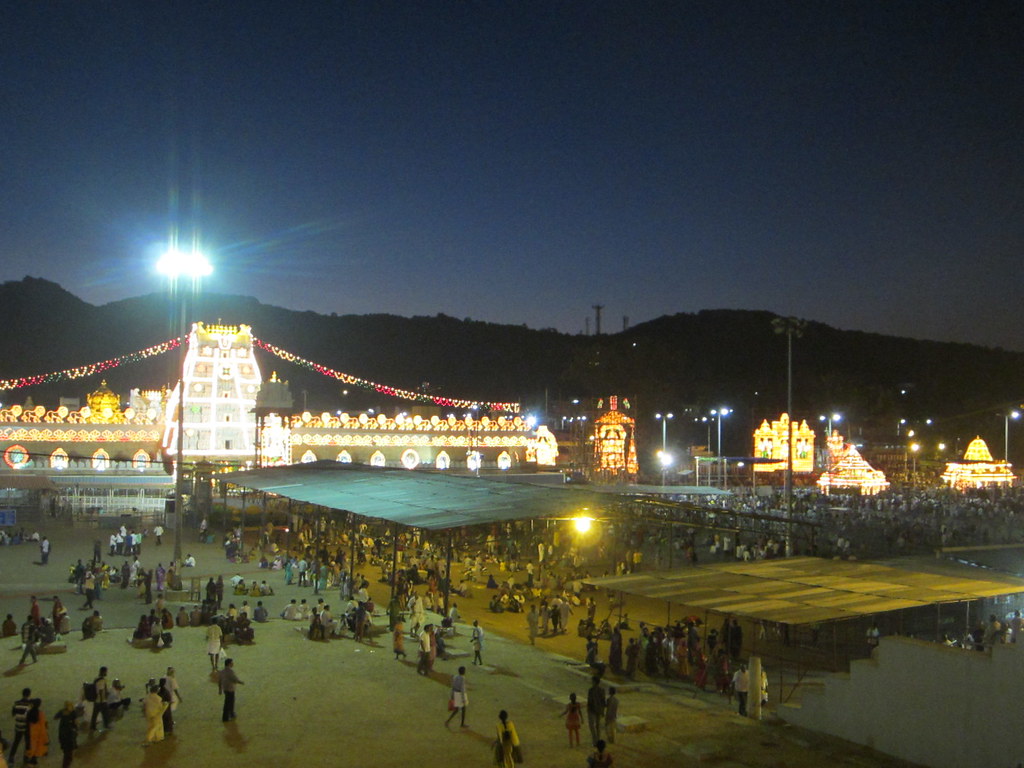Disclosure: We’re reader-supported. When you buy through links on our site, we may earn an affiliate commission at no extra cost to you. For more information, see our Disclosure page. Thanks.
Tirupati Itinerary for 3 days
Tirupati, located in the Indian state of Andhra Pradesh, is one of the most revered pilgrimage destinations in the country. It is renowned for the Tirumala Venkateswara Temple, dedicated to Lord Venkateswara, an incarnation of Lord Vishnu, which draws millions of devotees from all over the world. The town is not only a spiritual hub but also offers a rich cultural heritage, stunning landscapes, and historical landmarks that attract tourists of all kinds. Planning a visit to Tirupati requires careful consideration of the temple’s rituals, travel logistics, accommodation, and local attractions. This guide aims to provide a detailed itinerary for a visit to Tirupati, encompassing the best of the temple, the town, and its surroundings, along with useful tips and frequently asked questions (FAQs) to help you make the most of your trip.
Day 1: Arrival and Darshan of Lord Venkateswara
Morning: Arrival in Tirupati
Upon arrival in Tirupati, either via train, bus, or flight, the first step is to head to your hotel to check-in and freshen up. Tirupati is well-connected to major cities in India, with the nearest airport being Tirupati Airport (TIR), located about 15 km from the town center. If you’re traveling by train, the Tirupati Railway Station is another convenient point of entry. Upon arrival, it’s advisable to have a light breakfast before starting your day’s journey.

Mid-morning: Journey to Tirumala
The highlight of any visit to Tirupati is the darshan (viewing) of Lord Venkateswara at the Tirumala Temple, located on the Tirumala Hill, around 22 km from Tirupati town. To reach the temple, one can either take a cab, a local bus, or the famous “Alipiri Steps” — a set of 3,500 steps that lead directly to the temple for a more devotional approach. The journey to Tirumala offers breathtaking views of the lush forests and hills, adding to the overall experience. The drive takes about 30 minutes, while climbing the steps takes roughly 3-4 hours, depending on one’s fitness level.
Noon: Temple Darshan
Once you reach Tirumala, the temple complex is located on the hilltop. The Tirumala Venkateswara Temple is famous for its Dravidian architectural style and for being one of the richest temples in the world, both in terms of the offerings from devotees and its cultural significance. The temple opens early in the morning and remains open until late evening. The darshan of Lord Venkateswara is considered to be highly auspicious, and people often spend hours in the queue. For those looking to skip the general queue, VIP darshan tickets can be booked online in advance for a faster and more comfortable experience.
During the darshan, devotees offer prayers, make donations, and receive the holy prasad, which is distributed in the temple premises. The experience of standing in front of the idol of Lord Venkateswara, who is said to bring prosperity and blessings, is profoundly spiritual.
Afternoon: Prasadam and Local Cuisine
After darshan, devotees usually partake in the sacred offerings of the temple, known as “Tirupati Laddu,” which is a sweet made of flour, sugar, and ghee. It is considered a symbol of divine blessing. You can also enjoy local South Indian cuisine at the many eateries around the temple. A traditional meal known as “Anna Prasadam” is served at the temple, which includes rice, sambhar, and other accompaniments, free of cost to devotees.
Evening: Rest and Relaxation
After a spiritually fulfilling day, head back to your hotel in Tirupati town for some rest. You can unwind by exploring nearby markets or visiting local temples, such as the Sri Kapileswarar Temple or the Sri Padmavathi Ammavari Temple.
Day 2: Exploring the Surroundings
Morning: Visit to Sri Kapileswarar Temple
Start the second day of your Tirupati itinerary by visiting the Sri Kapileswarar Temple, located about 3 km from the Tirupati Railway Station. This temple is dedicated to Lord Shiva and is known for its peaceful atmosphere. The temple is situated near a natural waterfall, adding to its scenic charm. A visit here provides a more serene experience, away from the hustle and bustle of the main temple.
Late Morning: Sri Padmavathi Ammavari Temple
After visiting Sri Kapileswarar, head to the Sri Padmavathi Ammavari Temple, located in Tiruchanoor, about 5 km from Tirupati. The temple is dedicated to Goddess Padmavathi, believed to be the consort of Lord Venkateswara. The temple is renowned for its spiritual significance, and visiting it completes the pilgrimage to Tirupati, as it is believed that the combined blessings of Lord Venkateswara and Goddess Padmavathi bring harmony and prosperity.
Afternoon: Visit to Talakona Waterfalls
Post-lunch, take a trip to Talakona Waterfalls, located about 50 km from Tirupati. This waterfall is set amidst dense forests and offers a picturesque and tranquil retreat. You can take a dip in the cool waters or just relax amidst nature. The waterfall is also known for its medicinal properties, as the water is believed to have therapeutic benefits.
Evening: Shopping and Relaxation
Return to Tirupati in the evening and spend some time shopping for souvenirs. The local markets in Tirupati offer a variety of religious items such as idols, pendants, and T-shirts with images of Lord Venkateswara. Traditional handicrafts, clothes, and South Indian spices also make for great souvenirs. You can visit the local mall or the busy streets near the temple to explore these offerings.
Day 3: Exploring the Outer Region
Morning: Visit to Chandragiri Fort
On your third day in Tirupati, consider a visit to the Chandragiri Fort, located about 15 km from Tirupati. The fort dates back to the 11th century and offers panoramic views of the surrounding landscape. It was once the capital of the Vijayanagara Kings and has an archaeological museum that showcases relics from that period. Exploring the fort will give you a deeper understanding of the region’s rich history.
Midday: Visit to Sri Kalyana Venkateswara Swamy Temple
Located about 11 km from Tirupati, this temple is another important religious site dedicated to Lord Venkateswara. Unlike the main temple in Tirumala, Sri Kalyana Venkateswara Swamy Temple offers a more peaceful experience with fewer crowds. It is said to be the place where Lord Venkateswara married Goddess Padmavathi, making it an important spot for devotees.
Afternoon: Visit to Sri Venkateswara National Park
For nature lovers, a visit to the Sri Venkateswara National Park is a must. The park, located around 10 km from Tirupati, is known for its rich biodiversity, serene atmosphere, and trekking trails. It is home to various species of animals and birds, making it a haven for wildlife enthusiasts.
Evening: Relax at Sri Varahaswami Temple
End your Tirupati itinerary with a visit to the Sri Varahaswami Temple, located near the Tirumala Temple. Dedicated to Lord Vishnu’s boar incarnation, this temple is less crowded and offers a peaceful setting for reflection and prayer.
Accommodation in Tirupati
Tirupati has a range of accommodation options, ranging from budget hotels to luxury resorts. The Tirumala Tirupati Devasthanams (TTD) also offers guesthouses for pilgrims, which can be booked in advance. Most hotels offer shuttle services to and from the temple, making it convenient for visitors.
FAQs:
Q1: How can I reach Tirupati? Tirupati is well-connected by air, rail, and road. The nearest airport is Tirupati Airport (TIR), and the city is also served by the Tirupati Railway Station. Several buses and cabs operate from nearby cities like Chennai and Bangalore.
Q2: When is the best time to visit Tirupati? The best time to visit Tirupati is during the cooler months from October to March. Summers (April to June) can be hot, and monsoons (July to September) bring heavy rains, which may affect travel.
Q3: Is the Tirumala Temple open every day? Yes, the Tirumala Venkateswara Temple is open every day, with darshan available from early morning to late evening. Special rituals and festivals may affect the timing, so it’s best to check in advance.
Q4: How can I book darshan tickets? Darshan tickets for the Tirumala Venkateswara Temple can be booked online through the official TTD website or at designated counters in Tirupati. It’s advisable to book in advance, especially during peak seasons.
Q5: Are there any vegetarian food options in Tirupati? Yes, Tirupati offers a wide range of vegetarian food, including traditional South Indian cuisine such as dosa, idli, and sambhar. The temple also serves Anna Prasadam (free meal) to devotees.
Q6: Can I take the steps to Tirumala for darshan? Yes, pilgrims can choose to climb the 3,500 steps from Tirupati to Tirumala. The climb takes about 3-4 hours, and there are rest stops along the way.
Q7: What is the significance of the Laddu offered at the temple? The Tirupati Laddu is a sacred offering, and it is believed that taking the Laddu prasad blesses devotees with prosperity and success.
Conclusion
A trip to Tirupati is not only a religious pilgrimage but also an opportunity to explore the cultural and natural beauty of the region. From the sacred darshan of Lord Venkateswara to exploring the surrounding temples, parks, and historical sites, there is much to see and do. Proper planning can help you make the most of your time in Tirupati, ensuring a memorable and spiritually enriching experience.


